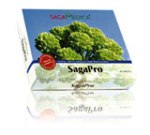 Antiviral properties of the medicinal herb Angelica archangelica make it useful in prevention of viral infections. Similarities between flu strains suggest the herb may be helpful in preventing infection from Swine flu, also known as Influenza A.
Antiviral properties of the medicinal herb Angelica archangelica make it useful in prevention of viral infections. Similarities between flu strains suggest the herb may be helpful in preventing infection from Swine flu, also known as Influenza A.
Research conducted since 1992 by Prof. Dr. Sigmundur Gudbjarnason and associates, shows that the leaves of the Icelandic variety of Angelica archangelica contain potent bioactive compounds that help prevent virus infections, such as cold or flu.
These compounds inhibit the proliferation of viruses and strengthen the body against viral infection, according to Dr. Gudbjarnason, head of research and development at SagaMedica and former President of the University of Iceland.
Link Between 1918 Flu Pandemic and Influenza A – Possible Usefulness of Angelica archangelica
“There are several important antiviral compounds in Angelica archangelica that might be important in prevention of viral infections. This should be considered if the Influenza A becomes a more severe epidemic and flu medication becomes scarce”, says Dr. Gudbjarnason
There are accounts of the Angelica archangelica being used as flu treatment in Denmark during the time of the Spanish influenza (1). Recent studies linking the origin of the Swine flu virus to the Spanish influenza (2) of 1918 further suggest that the herb may prove to be an effective prophylactic people can use to avoid infection if the Influenza A virus becomes more severe.
Herbal Remedies for Cold and Flu Prevention
SagaMedica produces a variety of dietary supplements from the Icelandic Angelica archangelica.
The herbal remedy SagaPro and Voxis lozenges are produced from leaves of the angelica herb and contain the antiviral compounds in question. They may be used to prevent viral infection.
More information at www.sagamedica.com
1. “So sent som under den stora influenzaepidemi på 1920-1930 tallet anvendes dette medel i Danmark”
Nielsen, H. Läkeväxter förr och nu. Borås 1978. Sweden, page 187.
2. Kansas State University (2009, May 1). 1918 Flu Resulted In Current Lineage Of H1N1 Swine Influenza Viruses. ScienceDaily. Retrieved May 1, 2009, from http://www.sciencedaily.com /releases/2009/04/090430111640.htm






